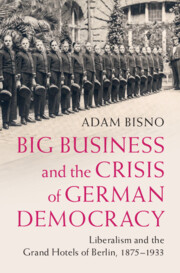 Big Business and the Crisis of German Democracy
Big Business and the Crisis of German Democracy Book contents
- Big Business and the Crisis of German Democracy
- Publications of the German Historical Institute
- Big Business and the Crisis of German Democracy
- Copyright page
- Contents
- Figures
- Acknowledgments
- Introduction
- 1 Hospitality Incorporated
- 2 Managing Heterogeneity
- 3 Grand Hotels at War
- 4 Hoteliers against the Republic
- 5 Abdication of the Liberals
- Epilogue
- Bibliography
- Index
- References
- Big Business and the Crisis of German Democracy
- Publications of the German Historical Institute
- Big Business and the Crisis of German Democracy
- Copyright page
- Contents
- Figures
- Acknowledgments
- Introduction
- 1 Hospitality Incorporated
- 2 Managing Heterogeneity
- 3 Grand Hotels at War
- 4 Hoteliers against the Republic
- 5 Abdication of the Liberals
- Epilogue
- Bibliography
- Index
- References
Summary
- Type
- Chapter
- Information
- Big Business and the Crisis of German DemocracyLiberalism and the Grand Hotels of Berlin, 1875–1933, pp. 197 - 214Publisher: Cambridge University PressPrint publication year: 2023
- Creative Commons
- This content is Open Access and distributed under the terms of the Creative Commons Attribution licence CC-BY-NC-ND 4.0 https://creativecommons.org/cclicenses/


